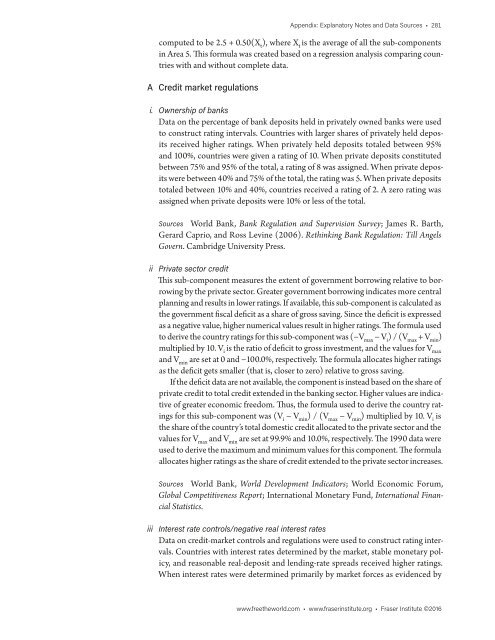Economic Freedom of the World
economic-freedom-of-the-world-2016
economic-freedom-of-the-world-2016
Create successful ePaper yourself
Turn your PDF publications into a flip-book with our unique Google optimized e-Paper software.
Appendix: Explanatory Notes and Data Sources • 281<br />
computed to be 2.5 + 0.50(X t ), where X t is <strong>the</strong> average <strong>of</strong> all <strong>the</strong> sub-components<br />
in Area 5. This formula was created based on a regression analysis comparing countries<br />
with and without complete data.<br />
A Credit market regulations<br />
i. Ownership <strong>of</strong> banks<br />
Data on <strong>the</strong> percentage <strong>of</strong> bank deposits held in privately owned banks were used<br />
to construct rating intervals. Countries with larger shares <strong>of</strong> privately held deposits<br />
received higher ratings. When privately held deposits totaled between 95%<br />
and 100%, countries were given a rating <strong>of</strong> 10. When private deposits constituted<br />
between 75% and 95% <strong>of</strong> <strong>the</strong> total, a rating <strong>of</strong> 8 was assigned. When private deposits<br />
were between 40% and 75% <strong>of</strong> <strong>the</strong> total, <strong>the</strong> rating was 5. When private deposits<br />
totaled between 10% and 40%, countries received a rating <strong>of</strong> 2. A zero rating was<br />
assigned when private deposits were 10% or less <strong>of</strong> <strong>the</strong> total.<br />
Sources <strong>World</strong> Bank, Bank Regulation and Supervision Survey; James R. Barth,<br />
Gerard Caprio, and Ross Levine (2006). Rethinking Bank Regulation: Till Angels<br />
Govern. Cambridge University Press.<br />
ii Private sector credit<br />
This sub-component measures <strong>the</strong> extent <strong>of</strong> government borrowing relative to borrowing<br />
by <strong>the</strong> private sector. Greater government borrowing indicates more central<br />
planning and results in lower ratings. If available, this sub-component is calculated as<br />
<strong>the</strong> government fiscal deficit as a share <strong>of</strong> gross saving. Since <strong>the</strong> deficit is expressed<br />
as a negative value, higher numerical values result in higher ratings. The formula used<br />
to derive <strong>the</strong> country ratings for this sub-component was (−V max − V i ) / (V max + V min )<br />
multiplied by 10. V i is <strong>the</strong> ratio <strong>of</strong> deficit to gross investment, and <strong>the</strong> values for V max<br />
and V min are set at 0 and −100.0%, respectively. The formula allocates higher ratings<br />
as <strong>the</strong> deficit gets smaller (that is, closer to zero) relative to gross saving.<br />
If <strong>the</strong> deficit data are not available, <strong>the</strong> component is instead based on <strong>the</strong> share <strong>of</strong><br />
private credit to total credit extended in <strong>the</strong> banking sector. Higher values are indicative<br />
<strong>of</strong> greater economic freedom. Thus, <strong>the</strong> formula used to derive <strong>the</strong> country ratings<br />
for this sub-component was (V i − V min ) / (V max − V min ) multiplied by 10. V i is<br />
<strong>the</strong> share <strong>of</strong> <strong>the</strong> country’s total domestic credit allocated to <strong>the</strong> private sector and <strong>the</strong><br />
values for V max and V min are set at 99.9% and 10.0%, respectively. The 1990 data were<br />
used to derive <strong>the</strong> maximum and minimum values for this component. The formula<br />
allocates higher ratings as <strong>the</strong> share <strong>of</strong> credit extended to <strong>the</strong> private sector increases.<br />
Sources <strong>World</strong> Bank, <strong>World</strong> Development Indicators; <strong>World</strong> <strong>Economic</strong> Forum,<br />
Global Competitiveness Report; International Monetary Fund, International Financial<br />
Statistics.<br />
iii Interest rate controls/negative real interest rates<br />
Data on credit-market controls and regulations were used to construct rating intervals.<br />
Countries with interest rates determined by <strong>the</strong> market, stable monetary policy,<br />
and reasonable real-deposit and lending-rate spreads received higher ratings.<br />
When interest rates were determined primarily by market forces as evidenced by<br />
www.free<strong>the</strong>world.com • www.fraserinstitute.org • Fraser Institute ©2016


